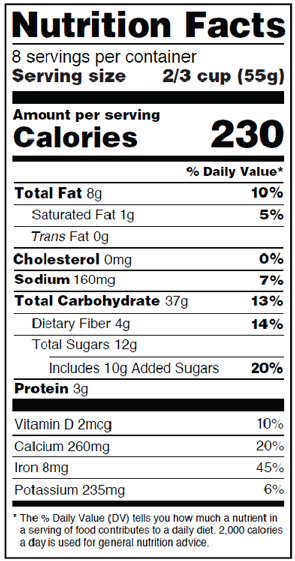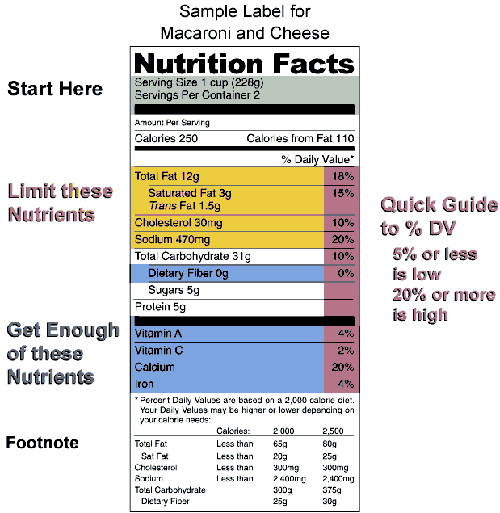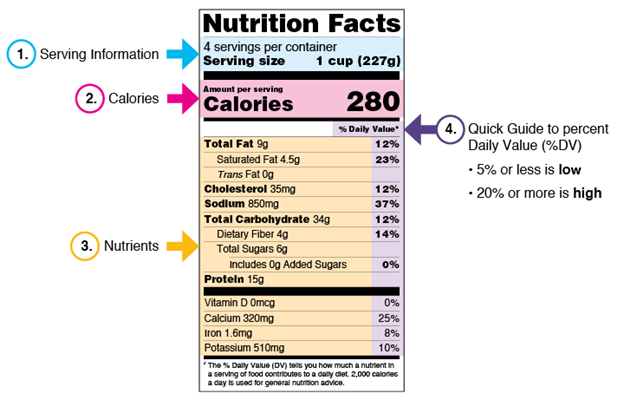43 do nutritional labels list only healthy nutrients
› food › new-nutrition-facts-labelHow to Understand and Use the Nutrition Facts Label | FDA Dietary fiber, vitamin D, calcium, iron ad potassium are nutrients on the label that Americans generally do not get the recommended amount of. They are identified as nutrients to get more of.... › article › 440416-fda-dailyFDA Daily Nutritional Requirements to Help You Eat Right Mar 20, 2019 · When you're reading about nutrition, you'll often see a variety of terms used to refer to your daily nutritional needs. These terms are issued by multiple bodies, including the Food and Nutrition Board or the Food and Drug Administration, or FDA. A few common labels you may have seen on nutritional information include:
Understanding Food Labels | The Nutrition Source | Harvard ... Under the Food Allergen Labeling and Consumer Protection Act of 2004, eight major food allergens—milk, fish, tree nuts, peanuts, shellfish, wheat, eggs, and soybeans—are required to be listed in a "contains" statement near the Ingredients list if present in a food. An example would be "contains wheat, milk, and soy."

Do nutritional labels list only healthy nutrients
Food Labels 101: Understanding the Nutrition Facts Label For a heart healthy diet, you should always try to keep your sodium intake to about 2300 mg per day. A sodium level of 140 mg or less on the nutrition facts label is considered low sodium. This is an essential number to look for when reading the label. Total Carbohydrates - Fiber and Sugar Your Guide to Nutrition Labels - EatingWell Vitamins and minerals. Vitamins A and C, calcium and iron are required to be listed on labels. They're shown in the form of Percent Daily Values. Daily Values are reference amounts set by the Food and Drug Administration (FDA). You can use Daily Values to help you understand how a food may help you meet your needs for a specific nutrient. New Nutrition Facts Label in 2020: Changes and What to Know The new nutrition facts label is intended to help provide consumers the information they need to make healthy dietary decisions. It also emphasizes specific nutrients that may be especially ...
Do nutritional labels list only healthy nutrients. Food Labeling & Nutrition | FDA Food labeling is required for most prepared foods, such as breads, cereals, canned and frozen foods, snacks, desserts, drinks, etc. Nutrition labeling for raw produce (fruits and vegetables) and... Nutritional labels list only healthy nutrients? True or false? The nutritional labels in the food products not only mention the healthy nutrients but also the components that need to be controlled in the diet.So, it is a false statement.. Further Explanation: The amount of fat, sugar, salt, and other nutrients in the food product can be tracked down by nutritional labels on them. › pmc › articlesBreakfast in Human Nutrition: The International Breakfast ... May 01, 2018 · The qualifying nutrients are protein, fiber, vitamin A, vitamin C, vitamin D, calcium, iron, potassium and magnesium. The disqualifying nutrients are saturated fat, added sugar and sodium. The NRF9.3 algorithm is the sum of the percent daily values for the 9 qualifying nutrients minus the sum of daily values of 3 disqualifying nutrients. › nutrition › nutritional-yeastNutritional Yeast: Nutrients, Health Benefits, and Uses Mar 24, 2022 · Nutritional yeast, also called “nooch,” is a popular food product often used in vegan cooking. This powdered yeast gets its name from the nutrients it contains, including protein and a wide ...
Food Labels | Nutrition.gov Food Labels Food labels can help you make healthy choices when buying food in grocery stores or restaurants. Labeling Organic Products USDA, Agricultural Marketing Service, National Organic Program Learn about organic foods, requirements, and how they are labeled. Calories on the Menu HHS, Food and Drug Administration Food labeling: MedlinePlus Medical Encyclopedia Their amounts are shown in grams (g) or milligrams (mg) per serving to the right of the nutrient. VITAMINS AND MINERALS Vitamin D, calcium, iron, and potassium are the only micronutrients required to be on the food label. Food companies can voluntarily list other vitamins and minerals in the food. PERCENT DAILY VALUE (% Daily Value) How to Read a Nutrition Label - WebMD The U. S. Food and Drug Administration (FDA) Center for Food Safety and Applied Nutrition says the first nutrients listed on the label --total fat, cholesterol, and sodium -- are the ones most ... Understanding Food Labels - Nutrition: Science and ... The value printed on the Nutrition Facts panel is the percent DV, which tells you how much one serving of the food contributes towards meeting the daily requirement for that nutrient. The FDA uses the following definitions for interpreting the %DV on food labels:4. 5%DV or less means the food is low in a nutrient.
Nutrition Labels 101: What's Required? What's Optional? The FDA requires nutrients that fall into one of these categories be listed on a nutrition label only when it's necessary to bolster or prove the label's food label or marketing claim. To best help consumers make informed decisions about their food choices, the FDA says all nutrition labels must include these 13 components. My Food Product: Do I Need Nutrition Facts On My Labels? This is the number one rule that requires nutrition fact labeling. If any exemptions are met, your food still has to include nutrition facts if the label has any nutrient claims. Small businesses (your own or any that sell your product) that have more than $50,000 of food sales AND more than $500,000 of total sales. 10 Things To Know About Nutrition Labels | wellwvu | West ... That means it gives you more nutrients (vitamins, minerals) with fewer calories. So the Deluxe wins. Percent Daily Values: These numbers never change; they're listed on every label and tell you what the recommended amount for each nutrient is, given a 2,000 or 2,500 calorie diet. Use it for a quick check. Food Labels | CDC If you eat the whole thing, you are eating 8 times the amount of calories, carbs, fat, etc., shown on the label. Total Carbohydrate shows you types of carbs in the food, including sugar and fiber. Choose foods with more fiber, vitamins, and minerals. Choose foods with lower calories, saturated fat, sodium, and added sugars. Avoid trans fat.
Nutrition: How to Read a Nutrition Facts Label ... You get your daily calories from what you eat and drink. A healthy person should consume nutrients from the five basic food groups (fruits, vegetables, grains, protein, and dairy). Some ingredients, such as saturated and trans fats, are unhealthy. You only should eat these in small amounts. A serving with 5% or less of the daily value is low.
Learn How the Nutrition Facts Label Can Help You Improve ... Nutrients Required on Label Vitamin D and potassium values are required. Calcium and iron will continue to be required. Vitamins A and C will no longer be required but can be included on a voluntary basis. Slight Decrease in Sodium Allowance The daily limit for sodium decreased slightly from 2,400 mg per day to 2,300 mg per day.
How to Read the Nutrition Facts Label | Ohioline Food packages often contain words and phrases like "low fat," "reduced sodium," "contains whole grain," and more to make consumers think a food is healthy. These words and phrases provide tidbits of information about food, but the nutrition facts label is the best tool to use to identify and select healthy choices. Figure 1: Changes to the Nutrition Facts Label Source: U.S. Food ...

Your Quick Guide to Reading Nutrition Labels | Nutrition labels, Nutrition, Healthy food guide
How To Read Nutrition Labels | HuffPost Life Nutrients listed: Nutrition food labels list the total calories, calories from fat, total fat, saturated and trans-fat, cholesterol, sodium, total carbs, dietary fiber, sugars, protein, iron, vitamins A and C, and calcium. Ingredients list: Ingredients are listed in order of weight. If sugar, for example, is the first ingredient, then there is ...
How to read a nutrition label | MD Anderson Cancer Center Total carbohydrates are divided in to two categories on a label, dietary fiber and sugar. Dietary fiber - Foods with fiber can help you feel full and satisfied. This helps you reduce your calorie intake and maintain a healthy weight. Foods with at least 3 grams of fiber per serving are considered a good source of this important nutrient.
› health › how-read-food-andHow To Read Food and Beverage Labels | National Institute on ... Additionally, many older adults do not get the recommended amounts of dietary fiber, vitamin D, calcium, and potassium. Eating enough foods that contain these nutrients can reduce the risk of developing some diseases and conditions, such as cardiovascular disease, osteoporosis, and high blood pressure.
The Basics of the Nutrition Facts Label Remember to aim high for percentage DV of these nutrients on other foods. Step 7: Consider the Additional Nutrients. You know about calories, but it also is important to know about the additional nutrients on the Nutrition Facts label. Protein: A percentage Daily Value for protein is not required on the label.
How To Read Nutrition Labels Like a Dietitian [Infographic] Nutrition labels are great; they help you figure out the ingredients and nutritional composition of a food product. Sometimes, though, they can be a bit deceitful. That snack may look healthy with only 6% of your daily saturated fat intake and 5% of your sodium, but take a closer look, and you realize that serving size is four crackers.
How to Decode a Nutrition Label - Healthline realizing that the nutrient values on labels are listed per serving size — and keeping track of how many servings you're eating understanding that labels don't list all nutrients important for good...
Nutrition Labels Flashcards | Quizlet Test. PLAY. Match. Gravity. nutrients. Click card to see definition 👆. Tap card to see definition 👆. Vitamins, minerals, and other things we get from food; used by our bodies to grow and stay healthy. Click again to see term 👆.
Food Labels & Nutrition Facts - Ask the Dietitian® Food Labels & Nutrition Facts. You have been so kind to take the time to answer my questions. Thank you so very much. Please permit me a couple of follow-up questions. The US Dietary Guidelines recommend moderate intake of sugar which includes sugar you add to food at the table as well as sugar added by food manufacturers.
Understanding Food Nutrition Labels | American Heart ... Make sure you get enough of the nutrients your body needs, such as: calcium, choline, dietary fiber, iron, magnesium, potassium, and vitamins A, C, D and E.* 5 - Understand % Daily Value. The % Daily Value (DV) tells you the percentage of each nutrient in a single serving, in terms of the daily recommended amount.
raisingchildren.net.au › nutrients › food-labelsFood labels & nutritional information | Raising Children Network Sep 23, 2020 · give you nutritional information about the food and food storage instructions; tell you who manufactured the food. Nutritional information panels (NIPs) are a part of the food label. These tell you what nutrients the food contains and how much of each nutrient there is. When you buy a packaged food product, have a look at the back of the packet ...
› en › healthy-livingUnderstanding Ingredients on Food Labels | American Heart ... Understanding Ingredients on Food Labels. Food labels are an important source of information about calories and the nutritional value of the foods you eat, a crucial tool in building a heart-healthy diet. The Nutrition Facts information is always displayed in the same orderly fashion and helps you understand how much of certain nutrients that ...











Post a Comment for "43 do nutritional labels list only healthy nutrients"